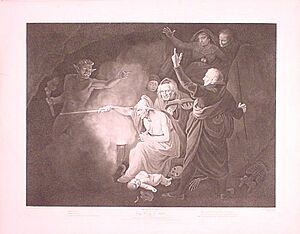Margery Jourdemayne facts for kids
Margery Jourdemayne, known as "the Witch of Eye Next Westminster," was an English woman who lived in the 1400s. She was accused of using magic and was executed on October 27, 1441. People believed she could tell the future and help with spells.
Life Story
Margery was married to William Jourdemayne. We don't know much about her own family. However, her husband's family, the Jourdemaynes, were well-known and successful farmers in Middlesex for a long time. Their family name probably came from an old French phrase meaning "day worker."
Her Activities
From the early 1430s, Margery spent time with important religious leaders and people from the royal court. This was a bit unusual for someone married to a cowherd (a person who looks after cows).
Eleanor Cobham, an important lady and wife of the Duke of Gloucester, said in her trial that she had used Margery's services for about ten years. Eleanor also said she asked Margery for help to have a baby with her husband. It seems that other ladies at the royal court also knew about Margery's skills.
In 1432, some of Margery's fellow prisoners at Windsor Castle included religious men. One of them, named Ashwell, was very good at astronomy (studying stars and planets). He even correctly predicted an eclipse in June 1433.
Roger Bolingbroke was a famous scholar who knew Margery. People said he was a "great and skilled man in astronomy" and "known all over the world."
Another person connected to Margery was Southwell, who was likely Eleanor's personal doctor. He was a very good doctor who worked at the royal court and in London. He was one of the people who asked the city to start a school for doctors and surgeons in 1423.
There is also some evidence that other important people used Margery's skills. For example, Edmund Beaufort, a duke, reportedly asked Margery for advice about upcoming battles. She told him he would be defeated and killed at a castle. But she also said that if he fought in an open field, he would win and be safe.
Her First Case in 1432
During her later trial in 1441, it was revealed that Margery had been held at Windsor Castle ten years earlier. This was for an unknown magic-related offense. In 1430, seven women accused of witchcraft were arrested in London. They were said to be plotting against the young King Henry VI. Margery might have been one of these seven.
On November 22, 1430, a royal officer was paid to take "a certain woman" from London to Windsor. Six days later, another officer was paid for taking Friar John Ashwell on the same trip. Records show that the keeper of Windsor Castle was paid for looking after Friar John and Margery Jourdemayne from November 18, 1430, to May 9, 1432.
On May 9, 1432, Margery, Friar John Ashwell, and John Virley (a clerk) were questioned about magic. Ashwell and Virley were released after promising to behave. Margery was also released, but only if she promised to behave well and stop practicing witchcraft.
Her Final Case in 1441
The case that led to Margery Jourdemayne's death has been well-recorded. Eleanor Cobham, the Duchess of Gloucester, was accused of using magic to harm the king. Four other people were also accused with her: Roger Bolingbroke, John Hume, Thomas Southwell, and Margery. They were all accused of using witchcraft to try and cause the death of King Henry VI. Eleanor's husband was next in line to the throne, which made the accusations very serious.
Three of the accused were scholars and religious men from the Duke's court. The fourth was Margery Jourdemayne, who was not from a rich or powerful family. She was accused of "false belief and witchcraft."
Sometime between July and September 1441, the king's men arrested Margery. She was taken to the Tower of London.
For many years, Margery was known as someone who could provide magic spells and special drinks. These were said to help with love or to help people have babies.
People wrote about her, saying she was an "old woman called the witch of Ey." They said she "worked wonders" and that even "spirits and fairies would obey her charming." They also claimed she could "raise dead bodies from the grave," calling her an "enchantress" with no equal at that time.
Margery was likely sentenced by a church court. There are no records left that confirm the exact charges. A famous lawyer named Edward Coke later said he had seen a document that stated she was burned under a law about burning people for heresy. She was executed by burning in Smithfield Market on October 27, 1441.
In Books and Plays
Margery Jourdemayne appears in William Shakespeare's play Henry VI, Part 2. In the play, she is called Margery Jourdayn and is shown with the others accused alongside her. She is also a character in Philippa Gregory's 2011 book The Lady of the Rivers, which is about Jacquetta of Luxembourg.


